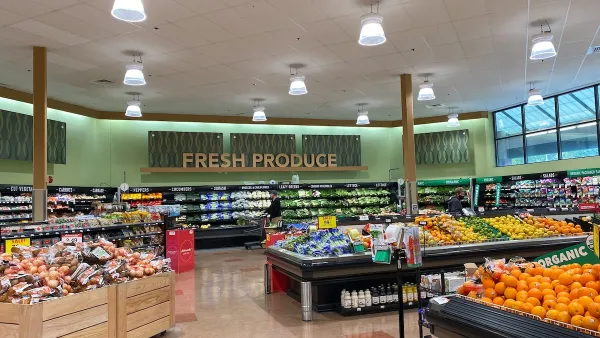A map of Pittsburgh's food deserts illustrates a nationwide problem with food insecurity.

Access to food and the role it can play in a person's life is an absolute vehicle for transformation and integration,” says Christina French, publisher of Table magazine.
In a country of agricultural bounty, it can be difficult to understand how so many people can lack for food. But 15 million American children are food-insecure. In Pittsburgh, 47 percent of the city reportedly lives in one of many food deserts. The problem becomes even more dire when we break down what constitutes "food." In many neighborhoods, the only source of "food" within walking distance is the corner store, markets that typically sell packaged junk food, sodas, and beer.
Reporting for the Pittsburgh Post-Gazette, Melissa McCart offers an explanation for how food desserts have come to be. High labor costs, economic downturn, and competition from big-box superstores such as Walmart have caused many grocery stores to close and consolidate. Residents of affected neighborhoods report travelling more than an hour by bus to reach a proper grocery store. Some of these neighborhoods, such as Oakland, home to the University of Pittsburgh, have streets filled with restaurants and bars, but such options are neither healthy nor affordable.
"Pittsburgh groups have been ramping up their efforts to address food insecurity, with varying degrees of success," reports McCart. Food pantries are expanding as well as focusing more on nutritional education. The Just Harvest program provides credits for EBT users to buy produce at farmers markets. Grow Pittsburgh is initiating community garden projects. Youth Places teaches food literacy to young restaurant workers.
"When people are hungry, the city suffers," McCart points out. "Charities have more to do."
FULL STORY: Food Deserts

Analysis: Cybertruck Fatality Rate Far Exceeds That of Ford Pinto
The Tesla Cybertruck was recalled seven times last year.

National Parks Layoffs Will Cause Communities to Lose Billions
Thousands of essential park workers were laid off this week, just before the busy spring break season.

Retro-silient?: America’s First “Eco-burb,” The Woodlands Turns 50
A master-planned community north of Houston offers lessons on green infrastructure and resilient design, but falls short of its founder’s lofty affordability and walkability goals.

Test News Post 1
This is a summary

Analysis: Cybertruck Fatality Rate Far Exceeds That of Ford Pinto
The Tesla Cybertruck was recalled seven times last year.

Test News Headline 46
Test for the image on the front page.
Urban Design for Planners 1: Software Tools
This six-course series explores essential urban design concepts using open source software and equips planners with the tools they need to participate fully in the urban design process.
Planning for Universal Design
Learn the tools for implementing Universal Design in planning regulations.
EMC Planning Group, Inc.
Planetizen
Planetizen
Mpact (formerly Rail~Volution)
Great Falls Development Authority, Inc.
HUDs Office of Policy Development and Research
NYU Wagner Graduate School of Public Service




























